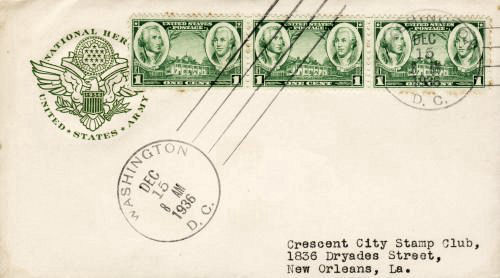![]()
Postal History Introduction
Stampless
Covers
1846
to 1900 Issues
1901-1950
Issues
1951-2003
Issues
Cancels
&
Miscellaneous
Postal
Stationery
Post
Cards
Air
Mail
First
Day &
Event Covers
Parcel Post/Special Delivery
Registered & Official Mail
Commercial & Advertising
Revenue & Postage Due
Wildlife & Game Issues
Complete List of RI Issues
|
Rhode Island Postal History
- Army Stamp Navy Issue |
|
|
|
|
Imperial Cachet -
Cachet Makers from 1934 to 1940 Nathanael Greene was born on May 27, 1742 in Potowomut, Rhode Island. Greene was named after his father, a respected Quaker minister. His mother, Mary Motte was his father's second wife. Nathanael's early education was sparse due to the family's Quaker beliefs. His schooling consisted of reading, writing and business math. However, he was an avid reader and sold miniature toys that he made himself in order to buy his books. He also received help from two learned men of the era; Lindley Murray a lawyer in the firm of John Jay and Ezra Stiles, a future president of Yale University. Nathanael began to form anti-British opinions after one of his father's ships, the Fortune was seized by the British Revenue Schooner Gaspee. The Gaspee later was burnt to the waterline by Rhode Islanders angry over the methods that Lieutenant Dudingston, her commander used to enforce revenue collection. (On June 10, 1772 in act of open civil defiance of British authority, Rhode Islanders boarded and sank the revenue cutter Gaspee in Narragansett Bay. Eight boatloads of armed citizens overpowered the crew of the Gaspee, which had run aground in pursuit of a smuggling vessel, shot her commander, and set fire to the ship. Despite concerted British efforts to bring the culprits to justice, the raiding party was never punished. The raiders were led by Captain Abraham Whipple - who later commanded the American warships Columbus and Providence. There was believed to be at least one Greene in the raiding party and Rufus Greene, a brother of Nathanael and former captain of the Fortune is the most likely candidate.) Nathanael's father bought an iron foundry in Coventry which Nathanael was assigned to manage. He began to take an active part in the community and he helped to establish the first public school in Coventry. Nathanael married Catharine Littlefield in 1774 and over the years she gave him six children. Nathanael served several terms in the colonial legislature and was elected as the commander of the Rhode Island Militia in 1775. He assumed the rank of Major General in 1776. Nathanael Greene served with Washington in the siege of Boston from 1775 to 1776 and in the fighting in and around New York City in 1776. He took part in the retreat across New Jersey after the British capture of Fort Washington in November 1776 and also led troops in the battles of Trenton, Brandywine and Germantown. After briefly serving as quartermaster general, Nathanael succeeded General Horatio Gates, (who had proved highly ineffective) as Commander in Chief of the Southern Army in October 1778. Opposed by a superior force under Lord Cornwallis, Greene decided to divide his own troops, thus forcing the division of the British as well. Greene's strategy led directly to General Daniel Morgan's victory at Cowpens, South Carolina on January 17, 1781. General Greene was defeated at the Battle of Guilford Courthouse in North Carolina on March 15, 1781, however the British troops were so weakened that General Cornwallis abandoned his plan to conquer North Carolina. General Greene then took the offensive and began the re-conquest of South Carolina. By the end of June, Greene had forced the British back to the coast. On September 8 he engaged the British under Lieutenant Colonel James Stuart at Eutaw Springs, where the British were so weakened that they withdrew to Charleston. He held them there for the remainder of the war. According to some historians, Greene's character was somewhat less solid than his generalship. There were charges of his having been in secret partnership with John Banks, an army contractor in the South, although the charges were never proved. There is also evidence that when Greene served as Quartermaster General he was in secret partnership with Jeremiah Wadsworth, the Commissary General of Purchases. Nevertheless, South Carolina and Georgia voted Greene liberal grants of land and money and in 1785 General Greene settled on an estate near Savannah, Georgia. General Nathanael Greene died on June 19, 1786 in Mulberry Grove, Georgia.
References: |
![]()
RI Historical
Society
The Post Offices
Home Page
RI Tercentenary Issue History
RI Philatelic Society
Recently Added Pages
Philatelic Primer
Rhode Island Around the World
Rhode Island
Town Postmarks
Other Websites of Interest
